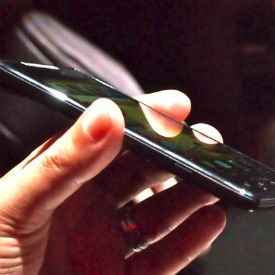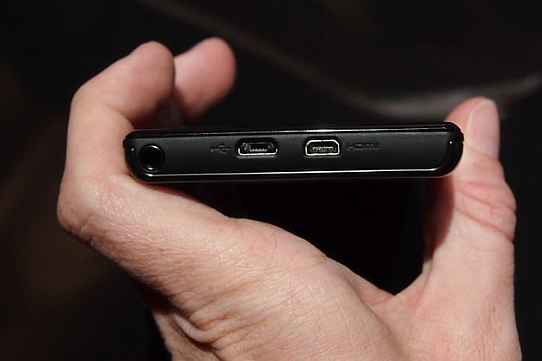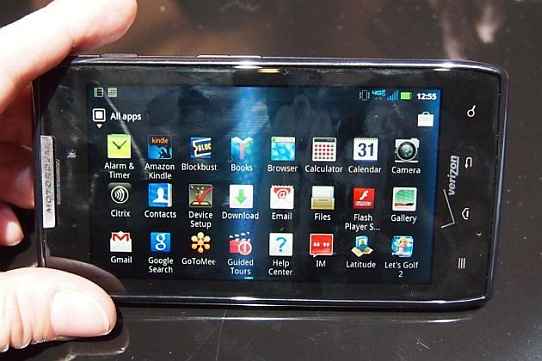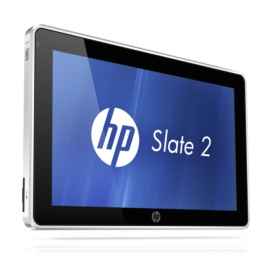Hands On: Motorola Droid Razr, HP Slate 2
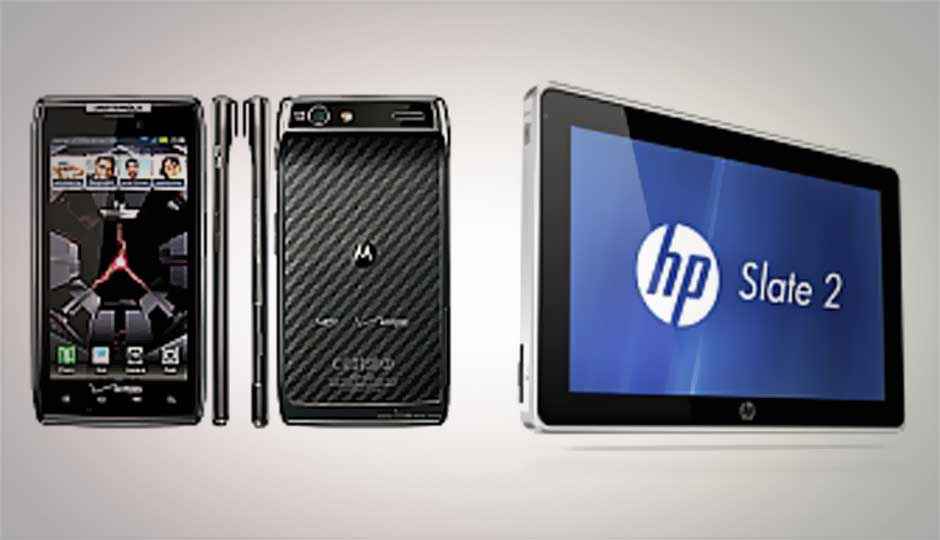
The Motorola Droid RAZR is the most gorgeous Android phone yet, and it definitely lives up to its name. I spent some time playing with the phone and talking to Motorola's engineers about how they got it to be so thin.
 Survey
SurveyThe Droid RAZR is one of those phones that feels even better in the hand than it does in pictures. Yes, it's ridiculously thin at 0.28 inches, smooth, and its material textures are a bit strange. My fingers couldn't quite place the feeling of the Kevlar back panel. It feels like plastic, but a little silkier. The 960-by-540, blessedly not-PenTile-format screen is an absolute stunner. It uses Samsung Super AMOLED Plus technology, Motorola said, but it's higher-res than any Samsung phone we've seen so far. The colors looked almost painted on.
This is a big phone, that's for sure, but that's the case with all 4.3-inch-display phones. There's also a considerable bezel around the screen, something Motorola's designers said they were working on reducing in future models. But it's still very handle-able, just because it's so darn thin.
The phone has the usual complement of ports, The top edge has a bulge for the 8-megapixel camera, so that's where Motorola also stuck the USB, HDMI, and headset jacks. On the side, there's a little door revealing the LTE SIM and MicroSD memory card slots. I couldn't find any way to remove the 1,800 mAh battery.
The phone runs a Moto-rized version of Android 2.3.5, with Motorola's social-networking widgets, a new power manager, and a bunch of extra apps. Stock Android fans won't be impressed, but everything ran apparently smoothly. To tell the truth, I kept stopping to go "ooh, pretty" about the screen. Madden 2012, for instance, was show-stoppingly beautiful. This screen is going to sell a lot of phones.
How's It So Thin?
The Droid RAZR uses a standard 1.2GHz dual-core TI OMAP4 (correction: I was earlier misinformed that it was Qualcomm) processor with separate CDMA and LTE modems, not the single-chip Qualcomm 8960 solution that's coming next year. The need to include a separate LTE chip has been cited by several manufacturers as why they can't get their phones razor-thin yet. So how did Motorola do it?
The company pared away layers and pieces that other phones take for granted, Motorola designers told me. For instance: most phones with removable batteries have a lining around the battery cavity. Not so with the Droid RAZR. Other phones, for instance the iPhone 4S, have their antennas perpendicular to the body of the phone. The Droid RAZR's antennas lie flat.
Using a dual-layer Samsung Super AMOLED Plus display helped save thickness over both LCD displays (because of the lack of a backlight) and standard Super AMOLED (because of a reduced number of process layers.)
[RELATED_ARTICLE]The total re-engineering of internal design in the Droid RAZR reminds me a lot of the original RAZR, which at the time of its launch was also a radical experiment in materials design. And like with the original RAZR, we may see the Droid RAZR's advances coming to a family of phones, the designers said. I asked about flip phones; they parried back with "folding phones" and phones that, in some way, start out smaller and become larger. A physically smaller, but still slab-shaped Droid RAZR variant may also be possible.
Droid RAZR With a Side of Ice Cream?
The Droid RAZR comes at a strange time, and in a strange place. It wipes away the Droid Bionic, Motorola's excellent smartphone that the company released just a few weeks ago, but it comes just a few hours before Google—Motorola's parent company—announces Ice Cream Sandwich, the new version of the Android OS, in Hong Kong.
As if to cement Google's support, Google executive chairman Eric Schmidt was sitting near me at the launch. But he didn't get up and didn't say a word.
Motorola spokeswoman Juli Burda said the company had nothing to say about Ice Cream Sandwich. Ditto for Verizon Wireless spokeswoman Brenda Raney. But we'll see if they change their tunes tomorrow.
The Motorola Droid RAZR goes on pre-sale on Oct. 27 for $299 with a two-year contract.
Read our Hands On with HP's latest Slate 2, on Page 2
Copyright © 2010 Ziff Davis Publishing Holdings Inc.
source:Hands On With the Motorola Droid RAZR
Hewlett-Packard may have dropped the underselling HP TouchPad like a hot rock, but its Windows tablet, the HP Slate 500 (now simply the HP Slate), stayed strong with healthy interest from business and vertical markets. This year, HP updates its Windows tablet with the HP Slate 2.
Like its predecessor, the HP Slate 2 will target the enterprise as well as markets like education, healthcare, and retail environments where freedom from a stationary desk is important. The Slate 2 has been updated with new processing hardware and expanded mobile connectivity.
The Slate 2 features an 8-inch screen with 1024-by-600 resolution, similar in size and shape to the one found on the previous model. The capacitive touch screen works with input from either fingers or a compatible stylus, and is multitouch capable. Ditching Windows' awkward on-screen keyboard, the Slate 2 uses the same Swype technology seen in other touch devices, like smartphones and Android tablets, letting you enter text and data with a single gliding motion, entering multiple letters without lifting your finger or stylus. The optional stylus can also be used to write on screen, utilizing Windows' hand-writing recognition or in conjunction with Evernote.
he Slate 2 measures 0.61 by 9.21 by 5.9 inches (HWD), and weighs 1.5 pounds. The dimensions may be similar to the previous Slate, but the appearance is quite different. Instead of the distinctive textured triangle pattern found on the back of the previous Slate, the Slate 2 has a smooth back with a semi-matte finish. On the back you'll also see the rear-facing 3-megapixel camera. On the front is a simple VGA Web camera set into the bezel.
The Slate 2 also benefits from new hardware, with a single-core 1.5-GHz Intel Atom Z670 processor, the same processor found in the Motion Computing CL900 and the Fujitsu Stylistic Q550. Designed specifically for tablets, the Atom Z670 is ideal for small spaces, like the chassis of a slim handheld tablet, and tailor-made to run the 32-bit version of Windows 7. The HP Slate 2 comes standard with the 32-bit version of Windows 7 Home Premium, but Windows 7 Embedded is also available.
[RELATED_ARTICLE]The Slate 2 will also be packing a number of business-friendly features to make it easy to integrate into an existing IT structure. The Slate 2 supports corporate images, and includes a number of security options, such as a TPM embedded security chip, HP Protect Tools, and Computrace Pro. Also, in a step up from the previous HP Slate, the Slate 2 will also be available with Gobi 3000 mobile broadband and HP Connection Manager, providing on-the-go connectivity in addition to 802.11n Wi-Fi. A Bluetooth 4.0 connection lets you wirelessly pair with peripherals like headsets, keyboards, and printers.
On the left edge of the tablet (when held in landscape orientation) you'll find an SD card slot, a button to toggle the on-screen keyboard, and a built-in microphone. On the right you've got a sliding power switch and a headset jack. On the top edge you'll find volume controls, a USB 2.0 port, a home button, and another button to toggle through open windows. On the bottom edge of the tablet is a dock connector that doubles as the power input.
The HP Slate 2 is equipped with an internal 2-cell 30Wh polymer battery, which HP claims will provide six hours of run-time on a single charge. Like any performance claim, we'll refrain from commenting until we've had a chance to test it in our labs.
Accessories available for the Slate 2 include a leather folio case with Bluetooth keyboard, a dock and stylus, and a case. The leather case features a compact Bluetooth chiclet keyboard, which should provide much of the desktop functionality that is so often missed when working with Windows on a tablet. This adjustable case can also be used to prop up the Slate 2 into something akin to traditional desktop or notebook, with the screen on edge, like a monitor. Another case, which we didn't get a chance to see, is made for retailers, and includes an integrated magnetic stripe reader and barcode scanner.
The HP Slate 2 starts at $699, and is expected to be available later this month.
Copyright © 2010 Ziff Davis Publishing Holdings Inc.
